Vinay Kumar Chapala
Path Loss Modeling for RIS-Assisted Wireless System with Direct Link and Elevation Factors
Feb 16, 2024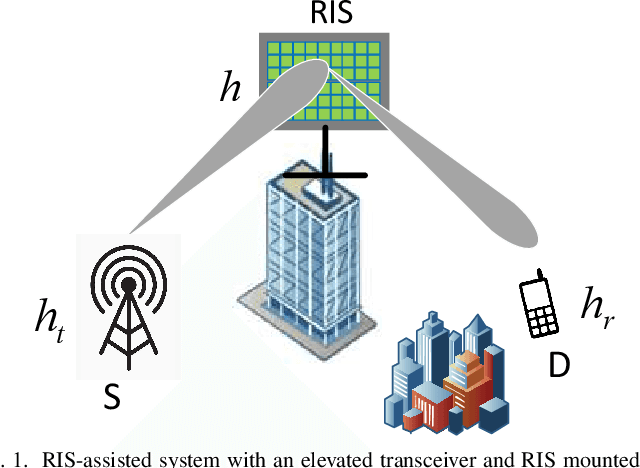
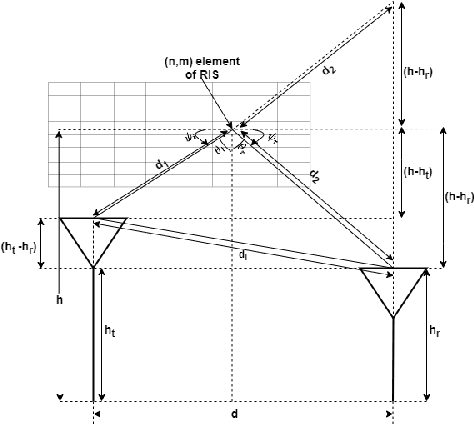
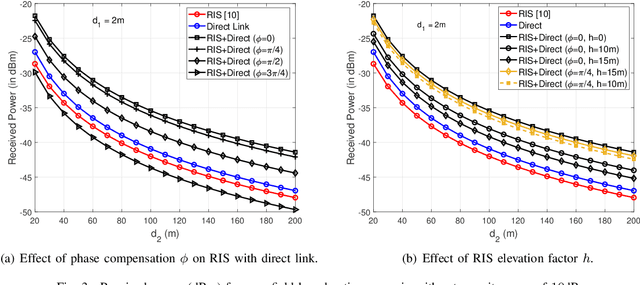
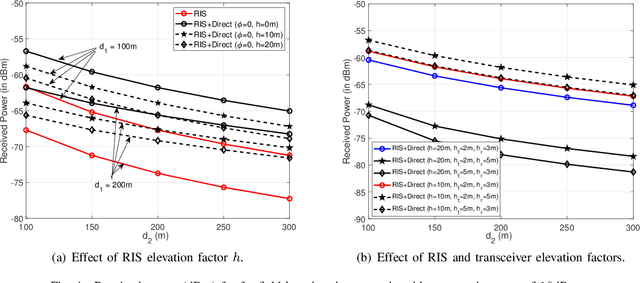
Abstract:The present path loss models for wireless systems employing reconfigurable intelligent surfaces (RIS) do not account for the elevation of the transmitter, receiver, and RIS module. In this paper, we develop an analytical model for path loss of a wireless system utilizing an NxM-element RIS module positioned above the ground surface with elevated transmitter and receiver configurations. Furthermore, we integrate the direct link into the path loss model to enhance its applicability, a crucial aspect often neglected in previous research. We also present simplified analytical expressions for path loss under various configurations, including near-field and far-field scenarios. These expressions elucidate the impact of elevation factors on path loss, facilitating more accurate signal quality estimation at the receiver. Simulation results corroborate that accounting for elevated RIS modules and transceiver units can yield improved deployment strategies for RIS-based wireless systems.
RIS-THz Wireless Communication with Random Phase Noise and Misaligned Transceiver
Nov 16, 2022

Abstract:Existing research works on reconfigurable intelligent surfaces (RIS) based terahertz (THz) system ignores the effect of phase noise and employ the zero-boresight pointing errors model of the free-space optics channel in performance analysis. In this paper, we analyze the performance of RIS-THz transmission under the combined effect of channel fading, THz pointing error (TPE), and statistical phase noise due to imperfect phase compensation at each RIS element. First, we derive statistical results of the double $\alpha$-$\mu$ fading combined with the TPE and phase noise at individual RIS elements using single-variate Fox's function. Next, we use the multi-variate Fox's H-function representation to develop exact analytical expressions for the density and distribution functions of the resultant signal-to-noise ratio (SNR) of the RIS-THz link considering the accumulating propagation effect from all RIS elements. Using the derived statistical results, we analyze the exact and asymptotic expressions for the considered system's outage probability and average bit-error rate (BER). The analytical results show that the diversity order of the system is independent of phase noise, depends on the channel fading parameters $\alpha$ and $\mu$, and depends on the $\beta$ parameter of the TPE.
Reconfigurable Intelligent Surface for Vehicular Communications: Exact Performance Analysis with Phase Noise and Mobility
Sep 21, 2022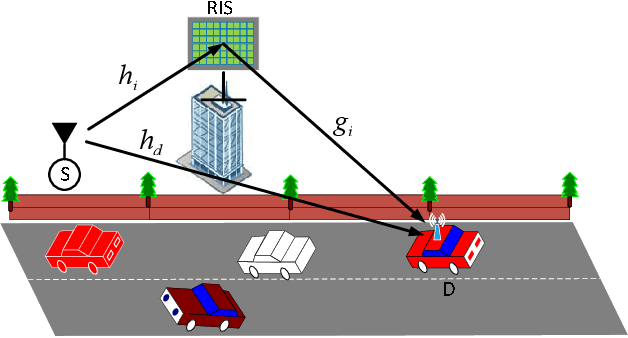
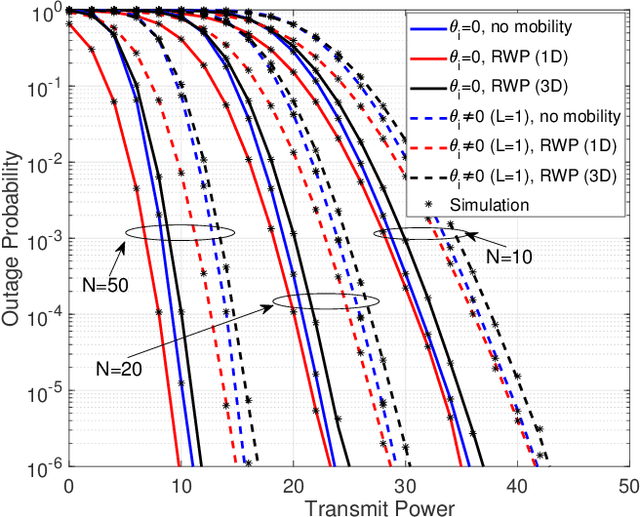
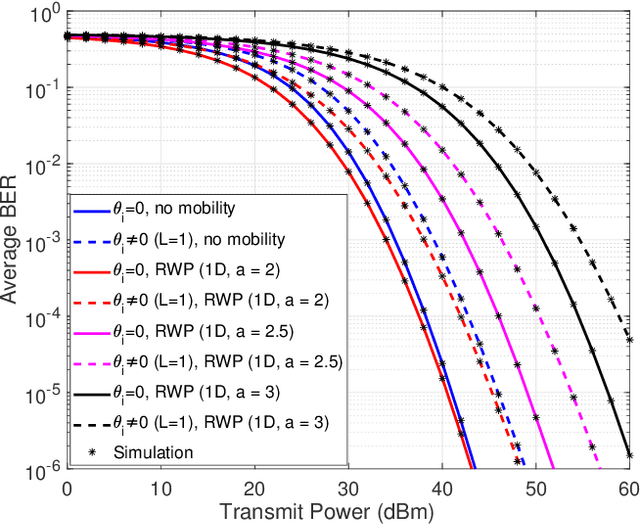
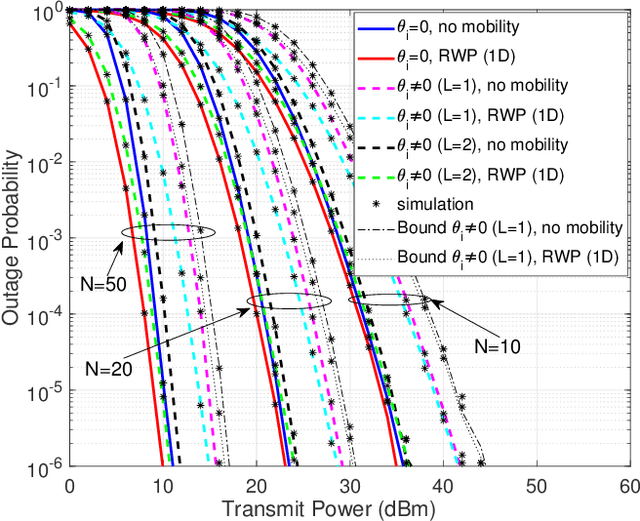
Abstract:Recent research provides an approximation on the performance for reconfigurable intelligent surface (RIS) assisted systems over generalized fading channels with phase noise resulting from imperfect phase compensation at the RIS. In this paper, we developed exact analysis and upper bounds on the performance of RIS-assisted vehicular communication system considering phase noise with mobility over asymmetric fading channels by coherently combining received signals reflected by RIS elements and direct transmissions from the source terminal. We employ a novel approach to represent the PDF and CDF of the product of four channel coefficients in terms of a single univariate Fox-H function. We use the derived PDF to develop an exact statistical analysis of the end-to-end SNR for the RIS-assisted system using multi-variate Fox-H function.
RIS-Assisted Vehicular Network with Direct Transmission over Double-Generalized Gamma Fading Channels
Apr 21, 2022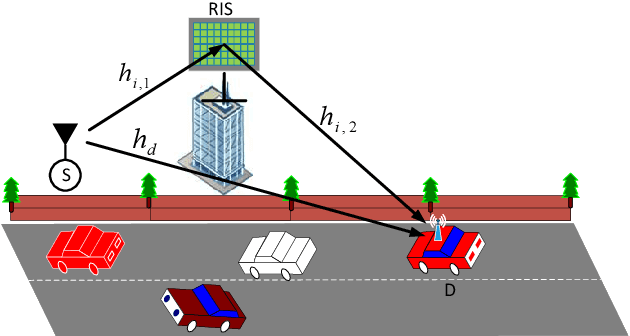
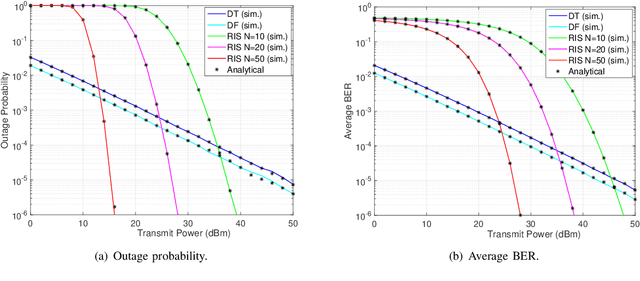
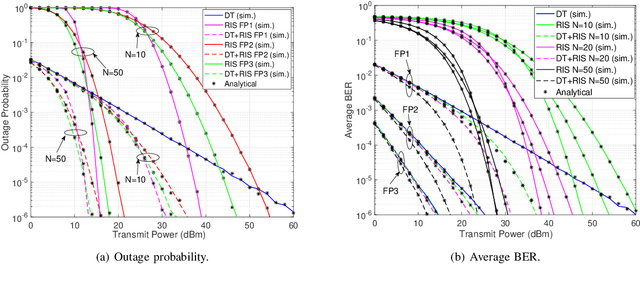

Abstract:Reconfigurable intelligent surface (RIS) can provide stable connectivity for vehicular communications when direct transmission becomes significantly weaker with dynamic channel conditions between an access point and a moving vehicle. In this paper, we analyze the performance of a RIS-assisted vehicular network by coherently combining received signals reflected by RIS elements and direct transmissions from the source terminal over double generalized Gamma (dGG) fading channels. We present analytical expressions on the outage probability and average bit-error rate (BER) performance of the considered system by deriving exact density and distribution functions for the end-to-end signal-to-noise ratio (SNR) resulted from the finite sum of the direct link and product of channel coefficients each distributed according to the dGG. We also develop asymptotic analysis on the outage probability and average BER to derive diversity order for a better insight into the system performance at high SNR. We validate the derived analytical expressions through numerical and simulation results and demonstrate scaling of the system performance with RIS elements and a comparison to the conventional relaying techniques and direct transmissions considering various practically relevant scenarios.
RIS-Assisted Multihop FSO/RF Hybrid System for Vehicular Communications over Generalized Fading
Dec 24, 2021
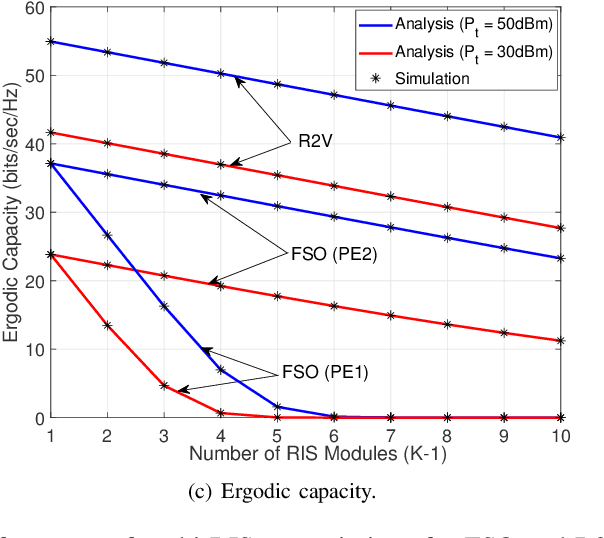
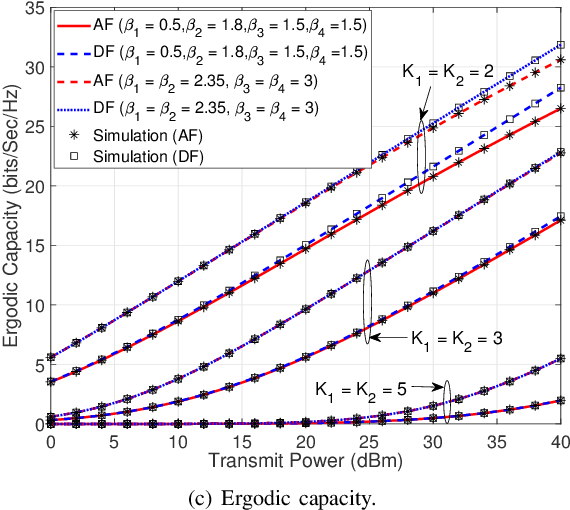
Abstract:Reconfigurable intelligent surface (RIS) is a promising technology to avoid signal blockage by creating line-of-sight (LOS) connectivity for free-space optical (FSO) and radio frequency (RF) wireless systems. There is limited research on the use of multiple RIS between a source and destination for wireless communications. This paper analyzes the performance of a RIS-assisted multi-hop transmission for vehicular communications by employing multiple RIS to enable LOS communication and reliable connectivity for a hybrid FSO and RF system. We develop an analytical framework to derive statistical results of the signal-to-noise ratio (SNR) of a multi-RIS communication system over general fading models. We use decode-and-forward (DF) and fixed-gain (FG) relaying protocols to mix multi-RIS transmissions over RF and FSO technologies, and derive probability density and distribution functions for both the relaying schemes by considering independent and non-identical double generalized gamma (dGG) distribution models for vehicular RF transmissions and atmospheric turbulence for FSO system combined with zero-boresight pointing errors. We analyze the performance of a moving vehicle connected to one of the RIS modules by deriving exact analytical expressions of the outage probability, average bit-error rate (BER), and ergodic capacity in terms of Fox's H-function. We present asymptotic analysis and diversity order of the outage probability in the high SNR regime to provide a better insight into the system performance. We use computer simulations to demonstrate the effect of multiple RIS modules, fading parameters, and pointing errors on the RIS-aided multi-hop transmissions for the considered vehicular communication system.
Multihop RIS-Assisted FSO-RF System Over Double Generalized Gamma Fading
Aug 16, 2021
Abstract:Reconfigurable intelligent surface (RIS) is a promising technology to avoid signal blockage by creating virtual line-of-sight (LOS) connectivity for free-space optical (FSO) and radio frequency (RF) wireless systems. This paper considers a mixed FSO-RF system by employing multiple RISs in both the links for multihop transmissions to extend the communication range. We develop probability density function (PDF) and cumulative density function (CDF) of the signal-to-noise ratio (SNR) for the cascaded channels by considering double generalized gamma (dGG) turbulence with pointing errors for the FSO link and the dGG distribution to model the signal fading for the RF. We derive exact closed-form expressions of the outage probability, average bit-error-rate (BER), and ergodic capacity using the decode-and-forward (DF) relaying for the mixed system. We also present asymptotic analysis on the performance in the high SNR regime depicting the impact of channel parameters on the diversity order of the system. We use computer simulations to demonstrate the effect of system and channel parameters on the RIS-aided multihop transmissions.
Unified Performance Analysis of Reconfigurable Intelligent Surface Empowered Free Space Optical Communications
Jun 03, 2021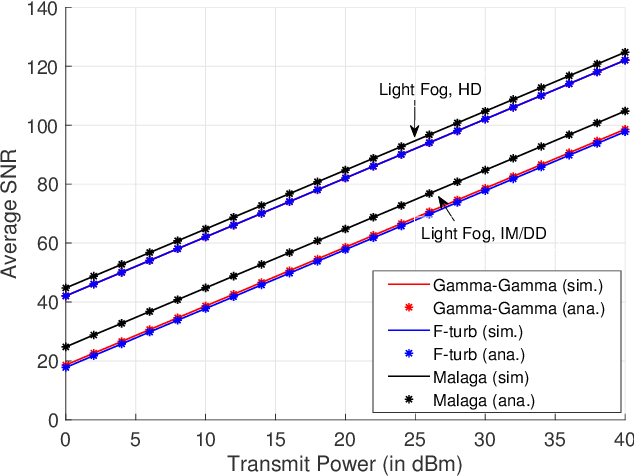
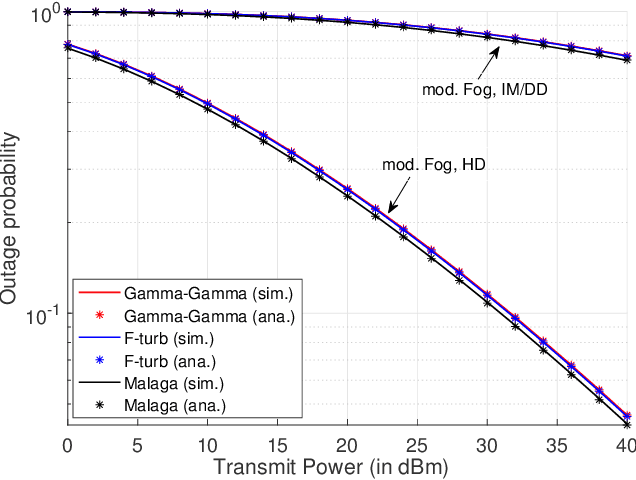
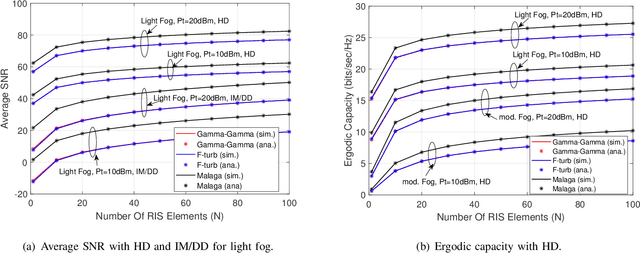
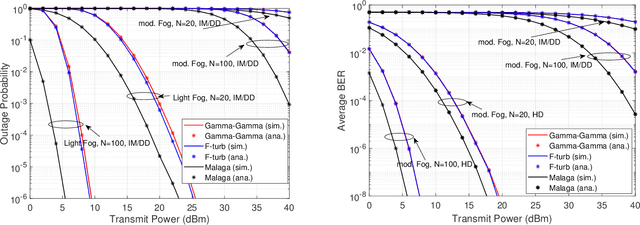
Abstract:Reconfigurable intelligent surface (RIS) is an excellent use case for line-of-sight (LOS) based technologies such as free-space optical (FSO) communications. In this paper, we analyze the performance of RIS-empowered FSO (RISE-FSO) systems by unifying Fisher-Snedecor (F), Gamma-Gamma (GG), and Malaga (M) distributions for atmospheric turbulence with zero-boresight pointing errors over deterministic as well as random path-loss in foggy conditions with heterodyne detection (HD) and intensity modulation/direct detection (IM/DD) methods. By deriving the probability density function (PDF) and cumulative distribution function (CDF) of the direct-link (DL) with the statistical effect of atmospheric turbulence, pointing errors, and random fog, we develop exact expressions of PDF and CDF of the resultant channel for the RISE-FSO system. Using the derived statistical results, we present exact expressions of outage probability, average bit-error-rate (BER), ergodic capacity, and moments of signal-to-noise ratio (SNR) for both DL-FSO and RISE-FSO systems. We also develop an asymptotic analysis of the outage probability and average BER and derive the diversity order of the considered systems. We validate the analytical expressions using Monte-Carlo simulations and demonstrate the performance scaling of the FSO system with the number of RIS elements for various turbulence channels, detection techniques, and weather conditions.
 Add to Chrome
Add to Chrome Add to Firefox
Add to Firefox Add to Edge
Add to Edge